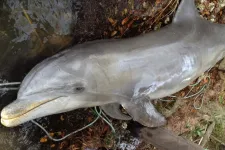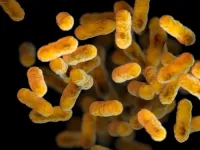(Press-News.org) In 2013, 8% of the bottlenose dolphins living in Florida’s Indian River Lagoon died. Investigations have now revealed that the dolphins may have starved because key habitats for nutritious prey were destroyed by a phytoplankton bloom. This bloom was driven by the accumulation in the lagoon of fertilizer, effluent from septic tanks, and other by-products of human activity that are rich in nutrients like nitrogen and phosphorus.
“We linked mortality and malnutrition to a decreased intake of energy following a shift in dolphins’ diets,” said Dr Charles Jacoby of the Florida Flood Hub for Applied Research and Innovation, corresponding author of the article in Frontiers in Marine Science. “We linked the dietary shifts to changes in prey availability, and we connected changes in prey to system-wide reductions in the abundance of seagrass and drifting macroalgae. These reductions were driven by shading from an intense, extensive, and long-lasting bloom of phytoplankton.”
Signs of trouble
In 2013, scientists monitoring the Indian River Lagoon noticed that the dolphin population was struggling. 64% of the 337 dolphins they observed were underweight, 5% were emaciated, and 77 died: a toll classified as an unusual mortality event.
“An unusual mortality event is a stranding event that is unexpected and involves a significant die-off of any marine mammal,” explained Megan Stolen of the Blue World Research Institute, first author of the article. “The 2013 event was characterized by a marked increase in mortality and widespread evidence of malnourishment.”
Bottlenose dolphins are large, long-lived animals that eat relatively large amounts of many different types of prey, which means that any disruption to the local ecosystem can affect them. In this case, researchers suspected that critical changes were caused by a 2011 phytoplankton bloom that was fueled by nutrient-rich by-products of human activity flowing into, and accumulating in, the lagoon. The bloom shaded bottom-dwelling seagrass and macroalgae in large parts of the lagoon, killing off these key habitats for dolphins’ prey and potentially compromising the dolphins’ ability to hunt. But it’s difficult to prove what dolphins are eating: observations of dolphins feeding at the water’s surface don’t yield a full picture of their diets, and stranded dolphins often have empty stomachs.
Instead, the researchers focused on isotopic analysis of muscle biopsies collected from stranded dolphins between 1993 and 2013. The ratios of stable isotopes of carbon and nitrogen in muscle from dolphins represent a mixture of similar ratios in their prey, so — using reference values from prey species — the scientists could track dietary changes over time and compare them to contemporary fisheries monitoring and the presence of seagrass and macroalgae.
Ripple effect
The scientists found a shift in the dolphins’ diets: during 2011-2013, they ate more sea bream and less ladyfish — a more energy-dense fish associated with seagrass. This agreed with the fisheries monitoring, which recorded changes in the availability of the two species: less ladyfish and more sea bream. It also matched the falling abundance of seagrass and macroalgae habitat over the same period. The shift from ladyfish to sea bream meant that dolphins would need to eat about 15% more prey to acquire the same amount of energy.
“In combination, the shift in diets and the widespread presence of malnourishment suggest that dolphins were struggling to catch enough prey of any type,” said Wendy Noke Durden of Hubbs-SeaWorld Research Institute, a co-author. “The loss of key structural habitats may have reduced overall foraging success by causing changes in the abundance and distribution of prey.”
The data also tallied with causes of death recorded for stranded dolphins. Between 2000 and 2020, malnutrition caused 17% of all recorded deaths, but in 2013, this figure rose to 61%.
“All studies have their limitations,” cautioned co-author Dr Graham Worthy of the University of Central Florida. “We did not have data on ratios of stable isotopes in all the prey that dolphins were eating from 1993 to 1999, so we could not fully explain the shift in diets observed from that early period to 2000–2010. Additionally, the link between malnourishment and a change in diet would have been enhanced by stable isotope data from the muscle of surviving dolphins.”
“Blooms of phytoplankton are part of productive ecological systems,” said Jacoby. “Detrimental effects arise when the quantities of nutrients entering a system fuel unusually intense, widespread, or long-lasting blooms. In most cases, people’s activities drive these excess loads. Managing our activities to keep nutrients at a safe level is key to preventing blooms that disrupt ecological systems.”
END
Scientists link a phytoplankton bloom to starving dolphins in Florida
A phytoplankton bloom damaged habitats, deprived bottlenose dolphins of nutritious prey, and led to a sharp rise in strandings and deaths
2025-04-07
ELSE PRESS RELEASES FROM THIS DATE:
Local access to abortion services expanded with mifepristone in community pharmacies
2025-04-07
VIEW EMBARGOED ARTICLE
Before 2017, abortions were generally performed as procedures in fewer than 100 hospitals and clinics mostly in urban centres, leading to delayed care, particularly for people living in rural areas. Medication abortions, mainly via off-label use of methotrexate, were infrequent.
Researchers looked at population data from ICES to examine abortion service availability changes in Ontario from January 2017 to December 2022. Between 2017 and 2022, there were more than 226 000 abortions provided to 175 091 people. The proportion ...
KIMM lays groundwork for global expansion of “K-Machine” through strengthened international partnerships in Europe
2025-04-07
The Korea Institute of Machinery & Materials (President Seog-Hyeon Ryu, hereinafter referred to as KIMM) has signed international cooperation agreements with research institutions in Slovenia, a manufacturing technology powerhouse in Eastern Europe, and Germany, a leading country in advanced technologies in Europe. These agreements focus on virtual reliability prediction and carbon-free high-temperature heat pump technologies, while also expanding the foundation for international joint research on autonomous machining systems.
As part of KIMM’s global cooperation initiative “With KIMM, to the World,” this partnership ...
Dietary shift after migration increases cardiovascular risk by altering the composition of an individual's gut microbiome
2025-04-07
An Amsterdam UMC-led study has found that migrants, this case from West Africa to Europe, experience a ‘clear change’ in their microbiome composition as compared to their non-migrant peers in West Africa, which expose them to an increase of cardiovascular disease. These peer-reviewed findings are published today in the journal Gut Microbes demonstrating that participants who lost specific groups of microbes or acquired specific new groups of microbes had higher rates of cardiovascular ...
Viability of hospital-based emergency care in US faces peril
2025-04-07
The viability of hospital-based emergency care in the U.S. is at risk, threatened by issues such as patients with increasingly complex needs and falling payments for physicians, according to a new RAND report.
Many of the problems facing emergency medicine are expanding in scale, including long emergency department wait times, boarding patients in emergency department beds and a high amount of uncompensated care.
The issues are in focus as the use of hospital emergency departments return to levels seen before restrictions prompted by the COVID-19 pandemic limited use of emergency departments, according to researchers.
“Urgent action is needed to sustain hospital emergency ...
Exposure to air pollution may harm brain health of older adults
2025-04-07
Long-term exposure to high levels of air pollution may harm the brain health of older adults in England, finds a new study led by UCL researchers.
The research, published in The Journals of Gerontology: Series A, found that exposure to nitrogen dioxide (NO₂) and fine particulate matter (PM2.5) is linked to lower scores in key cognitive abilities, particularly language skills.
NO₂ mainly enters the atmosphere through fuel combustion, originating from emissions of vehicles like cars, trucks, and buses, as well as power plants and off-road machinery. PM2.5 pollution in outdoor air often originates from the ...
New study investigates effects of ADHD medications on the heart
2025-04-06
UNDER EMBARGO UNTIL 23.30 UK TIME ON SUNDAY 6TH APRIL 2025
New study investigates effects of ADHD medications on the heart
A new study led by the University of Southampton has found that medications for ADHD have overall small effects on blood pressure and heart rate after weeks or a few months of use.
There have been concerns about the side effects of ADHD medications but the new findings, coupled with other studies, suggest that the benefits of taking these medications outweigh the risks, while highlighting the need for careful monitoring.
The study, published in ...
Research to tackle Prymnesium algal blooms which affect fish populations
2025-04-06
A scientific initiative to combat harmful Prymnesium algal blooms in the Broads is gaining fresh momentum, thanks to a renewed collaboration between the University of East Anglia (UEA), the Environment Agency, the Broads Authority, and the Norfolk pike angling community.
Prymnesium algal blooms can occur on the Broads and produce toxins that threaten fish stocks, local biodiversity, and East Anglia’s thriving angling industry, which contributes more than £100 million annually to the local economy.
The golden algae Prymnesium parvum is therefore of significant research interest to ...
Climate and health litigation mounting in Australia as exposure to heatwaves grows
2025-04-06
Australia’s exposure to extreme heat continues to grow while the country has emerged as a global hotspot for climate change litigation, according to the latest MJA–Lancet Countdown report.
Released today, the report reveals Australia has experienced a 37 per cent increase in excess heat factor over the past 20 years.
Lead author and Director of the Lancet Countdown Centre in Oceania, Professor Paul Beggs from Macquarie University, says these findings underscore the importance of long-term tracking of climate hazards and exposures in Australia.
“The frequency of health-damaging heat has increased substantially since the 1970s," says Professor Beggs.
The ...
Young females more likely to experience higher social anxiety due to excessive smartphone use than other genders
2025-04-06
EMBAROGED UNTIL SUNDAY 6TH APRIL AT 08:00 CEST
YOUNG FEMALES MORE LIKELY TO EXPERIENCE HIGHER SOCIAL ANXIETY DUE TO EXCESSIVE SMARATPHONE USE THAN OTHER GENDERS
Sunday 6th April 08:00 CEST - A new study presented today at the European Psychiatric Association Congress 2025 reveals that gender plays a significant role in excessive and problematic (psychological or behavioural dependence)1 smartphone use, with young females more likely to experience higher social anxiety than other genders. In the study, it was also found that gender was significantly linked to the amount of time spent using smartphones ...
New research boosts future whooping cough vaccines
2025-04-04
Whooping cough, or pertussis, was once a leading cause of death for children in the U.S. and worldwide before the introduction of vaccines in the 1940s. In the decades since, the bacterial disease was nearly eradicated in the U.S., with fatalities falling to double digits each year.
But the disease has made a troubling comeback in recent years as vaccine coverage declined after the COVID-19 pandemic. In 2024, several outbreaks left public health officials and hospitals scrambling to accommodate a sudden influx of patients, primarily infants, who are often too young to be vaccinated and suffer the most severe symptoms.
Now, new research from The University of Texas at Austin could aid ...
LAST 30 PRESS RELEASES:
COVID-19 leaves a lasting mark on the human brain
Scientists use ultrasound to soften and treat cancer tumors without damaging healthy tissue
Community swimming program for Black youth boosts skills, sense of belonging, study finds
Specific depressive symptoms in midlife linked to increased dementia risk
An ‘illuminating’ design sheds light on cholesterol
Who is more likely to get long COVID?
Study showcases resilience and rapid growth of “living rocks”
Naval Research Lab diver earns Office of Naval Research 2025 Sailor of the Year
New Mayo-led study establishes practical definition for rapidly progressive dementia
Fossil fuel industry’s “climate false solutions” reinforce its power and aggravate environmental injustice
Researchers reveal bias in a widely used measure of algorithm performance
Alcohol causes cancer. A study from IOCB Prague confirms damage to DNA and shows how cells defend against it
Hidden viruses in wastewater treatment may shape public health risks, study finds
Unlock the power of nature: how biomass can transform climate mitigation
Biochar reshapes hidden soil microbes that capture carbon dioxide in farmland
Reducing saturated fat intake shows mortality benefit, but only in high-risk individuals
Manta rays create mobile ecosystems, study finds
Study: Mixed results in using lipoic acid to treat progressive multiple sclerosis
Norbert Holtkamp appointed director of Fermi National Accelerator Laboratory
New agentic AI platform accelerates advanced optics design
Biologists discover neurons use physical signals — not electricity — to stabilize communication
Researchers discover that a hormone can access the brain by hitchhiking
University of Oklahoma researcher awarded funding to pursue AI-powered material design
Exploring how the visual system recovers following injury
Support for parents with infants at pediatric check-ups leads to better reading and math skills in elementary school
Kids’ behavioral health is a growing share of family health costs
Day & night: Cancer disrupts the brain’s natural rhythm
COVID-19 vaccination significantly reduces risk to pregnant women and baby
The role of vaccination in maternal and perinatal outcomes associated with COVID-19 in pregnancy
Mayo Clinic smartwatch system helps parents shorten and defuse children's severe tantrums early
[Press-News.org] Scientists link a phytoplankton bloom to starving dolphins in FloridaA phytoplankton bloom damaged habitats, deprived bottlenose dolphins of nutritious prey, and led to a sharp rise in strandings and deaths





